Finding gorgeous shade garden plants that also add color to low light areas can be challenging. Don’t despair! You’re sure to find lots of great options in this list of flowering perennials for partial to full shade.
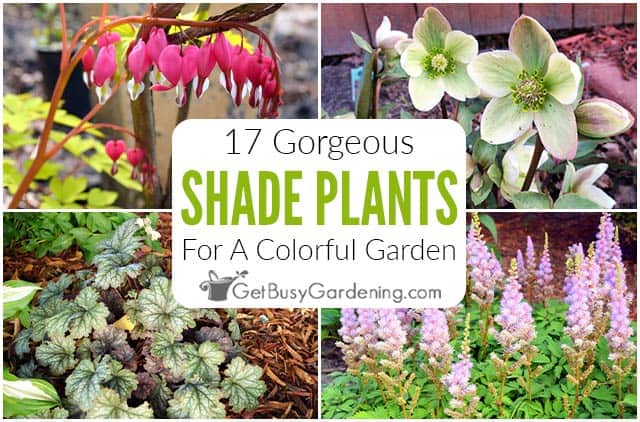
Shade Gardens Don’t Have To Be Boring!
Yep, I hear this all the time. The reason this is such a common feeling is because the most well known of all shade garden plants you see are BOR-ing (ehem, plain green hostas!).
Ok, confession time… I find hostas mundane and overdone (at least they are here in Minnesota).
Sure, there are tons of varieties to choose from. And, if they’re mixed well, they can be very pretty, or even colorful.
But, usually I see the same plain varieties plopped into a low light area in the garden. Hence the feeling that having shady beds is a bad thing.
Well no more of that nonsense! There’s no need to settle for dull greens and just one or two species to fill those sun-challenged areas.
Let’s think outside of the hosta box. Instead, use the following list to get creative with colors, foliage, and blooming times. In this list, you will find plenty of wonderful plants for shady gardens.
What Garden Plants Grow In Shade?
Many people think that if they’re stuck with a shady yard, they’ll be limited on the number of plants they can grow. On the contrary!
If this is you, you’ll be thrilled to know that you actually have tons of options to choose from!
By mixing any of the shade loving plants on this list, you’ll be able to create gorgeous and colorful gardens!
Related Post: How To Determine Sun Exposure In Your Garden
17 Gorgeous Shade Garden Plants
There are far more options for full or partial shade plants than you might think! All of these perennial flowers will bring bright spots of color to the darkest corners of your yard.
1. Helleborus (Lenten Rose)
These beautiful partial to full shade perennials add a nice pop of color year-round in your sun-challenged garden.
Lenten roses bloom in late winter to early spring, reaching a height of about 12-18”. The flowers are jeweled shades of pink, white, or purple that contrast nicely with the brighter hues from other plants.
Even when not in bloom, they have some really cool looking thick dark green foliage, which makes a fantastic backdrop for other plants.
Helleborus thrives in a wide range of areas and climates, all the way from zones 4 through 9.
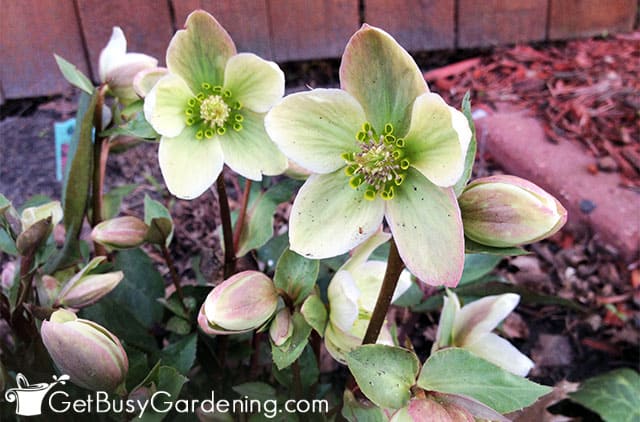
2. Snakeroot (Actaea)
This tall (36-48”) flowering plant likes full shade areas. It can tolerate partial morning or evening sun, but should be protected from a hot afternoon exposure.
Snakeroot does best in an area where the soil stays well watered. It likes a range of cool to temperate climates, thriving in zones 3-8.
It produces fragrant white flowers on tall spikes in late summer or fall. Bees love them, and they can add color to your shade garden even late in the season.
3. Lungwort (Pulmonaria)
A low mounding perennial plant (12-18” tall), lungwort does well in partial to full shade. It prefers moist soil, and will thrive in zones 4 to 9.
While it doesn’t have a pretty name, the foliage is quite amazing. It also gets small bright purple, pink, light blue, or white flowers in mid-spring.
I recommend the spotted leaf variety (Pulmonaria saccharata) – this cute polka dotted plant is one of my favorites.
I also love Pulmonaria longifolia ‘Diana Clare’, which is a hybrid that has very pretty silver leaves.
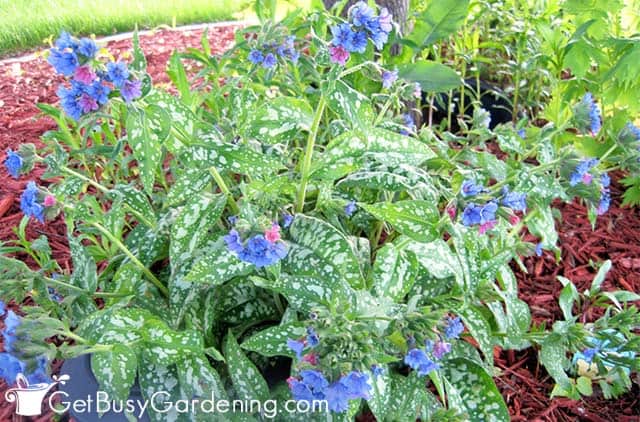
4. Delphinium (Larkspur)
These low clumping plants have tall spikes of delicate flowers that dominate their look, and they thrive in zones 3-8.
Delphiniums can do very well in part shade, as well as sunny areas – so you can’t go wrong with this one.
They bloom from mid-summer to fall, and can have pink, blue, purple, or white blossoms.
The tall flower spikes (36-48”) become heavy when in full bloom, and require staking in windy areas.
5. Astilbe
A medium-height perennial that blooms in mid-summer, astilbe forms unique wispy flower plumes that reach heights of 24-36”.
When in bloom, they add major pops of light pink to red color in the shade garden, and the foliage adds interest the rest of the year.
These light to partial shade plants need consistently moist soil, but make an incredible statement in low light areas.
They do best in zones 4 through 8. Plus you can leave the flower spikes in the garden for extra winter interest.
Related Post: 17 Pink Flowers For Your Garden (Annuals & Perennials)
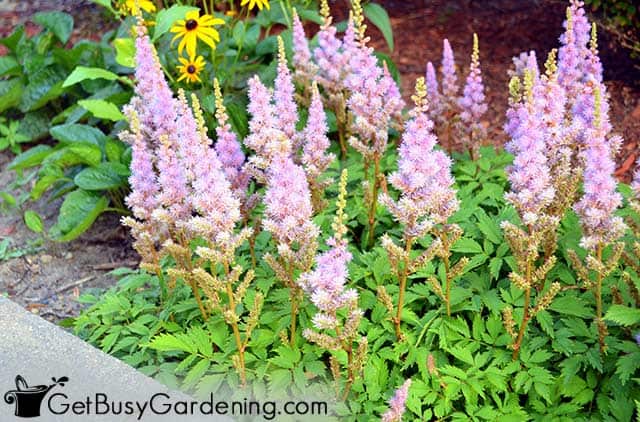
6. Brunnera
The large, delicate leaves of brunnera come in a variety of gorgeous patterns and colors.
The foliage can be anywhere from near white, to silver/gray, variegated, or yellow/green. All of these bright leaves really stand out in the shade.
While the blue flowers that form in spring are very pretty, this part to full shade perennial is known for the eye-popping foliage.
It prefers consistently moist soil, and does best in cooler climates (zones 3-7). Reaching heights of 12-18”, these interesting plants are a beautiful addition to shade gardens.
7. Bergenia
With its light green waxy leaves, bergenia is the perfect plant for any shade garden.
The bright leaves turn reddish-bronze when it gets cold, creating beautiful fall color. It also blooms in late winter or early spring, sending up short spikes of tiny pink flowers.
Staying low and compact, bergenia prefers the cooler climates of zones 4-7. This lovely little plant is also drought tolerant.

8. Irish Moss (Sagina)
This fabulous ground cover creates a lush, bright green carpet, and it doesn’t mind one bit if you walk on it.
It’s great for growing in the cracks and crevices of a shady garden path, or between pavers.
Irish moss does best in zones 4-10, preferring partial shade and some sun. It also produces tiny white flowers in late spring and early summer.
Once established, it spreads like any other moss – suddenly appearing in an unexpected place one day. A trait that some gardeners may not like, but I find very cool!
9. Bugleweed (Ajuga)
Noteworthy primarily for its foliage, bugleweed also gets lovely purple or pink 6” flower spikes in spring through early summer in zones 3-9.
It doesn’t flower as profusely in full shade as it does in partial sun. But the foliage is spectacular, and it makes an excellent ground cover that can take light foot traffic.
My favorite varieties are the pink variegated ‘Burgundy Glow’, the dark purple/almost black ‘Black Scallop’, and the green and white variegated ‘Silver Beauty’.

10. Jack-In-The-Pulpit (Arisaema)
Good plants for full shade, Jack-In-The-Pulpit are unusual, and make a lovely color addition to low light areas.
They add a woodland aesthetic, and are hardy in zones 3-9. This cool plant is 24-36” tall, and blooms in the spring.
It has very unique flowers that can range in color from green to dark purple/black, or maroon/burgundy.
In the fall, it gets bright red seed pods. They do sow themselves freely. So, if you don’t want this plant to spread, remove the pods before winter.
11. Coral Bells (Heuchera)
Coral bells are fantastic foliage plants for shade, and they thrive in a wide range of growing zones (4-9).
They have stunning foliage that comes in practically any color of the rainbow. Green, caramel, yellowish, red, purple, burgundy, maroon, or nearly black, depending on the variety.
These short bushy plants get 6-12” tall flower spikes in late spring through mid summer. The white or light pink blooms are insignificant, but do add extra interest.
You could do an entire shade garden using nothing but coral bells, and it would be very colorful. This plant is a definite must for any low light area!
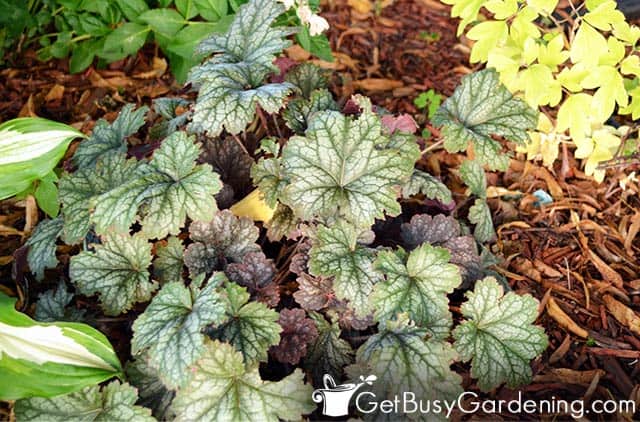
12. Solomon’s Seal (Polygonatum)
Variegated Solomon’s seal makes a wonderful backdrop for partial to full shade gardens in zones 3-8.
The bright green and white leaves really stand out, and it’s especially striking combined with plants that have dark colored foliage.
It also gets cute little white bell flowers that dangle down from underneath the 12-36” tall arching stems in the spring.
13. Bleeding Heart (Lamprocapnos)
This is a classic beauty in any zone 3-9 shade garden, and one of my favorite spring blooming plants.
They are best known for the delicate heart-shaped pink and white flowers that dangle down from 24-48” long, arching stems. But there is a variety that has pure white blooms instead.
I love all types of bleeding hearts, but the one with the chartreuse leaves (‘Gold Heart’) is especially stunning.
They do tend to spread more aggressively in partial shade, so make sure to plant it in a contained space if you don’t want it to take over.
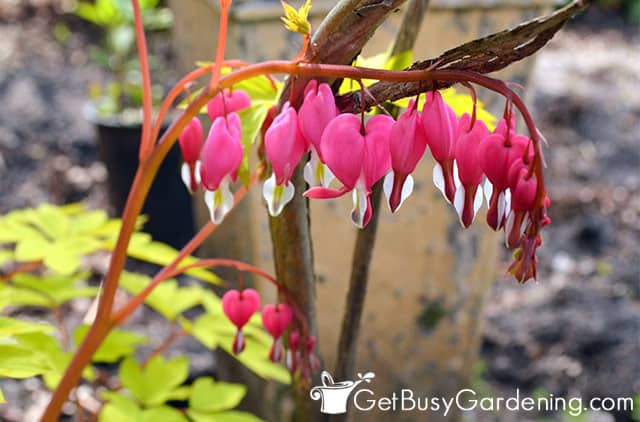
14. Loosestrife (Lysimachia)
As an excellent partial shade perennial, loosestrife has bright yellow flowers in mid-late summer, and vivid foliage.
At heights between 36” and 48” tall, they make a good mid-level layer with other plants in zones 5-9.
There are tons of varieties to choose from, and I especially love the ones with variegated leaves.
My two favorites are ‘Alexander’ (white and green variegated leaves) and ‘Golden Alexander’ (yellow and green variegated leaves).
Be careful about which type you plant, because some are very invasive (purple loosestrife is on the invasive species list here in MN).
15. Lamium (Spotted Dead Nettle)
There are lots of different varieties of lamium, but the one I have in my shade garden gets bright yellow leaves and pink flowers.
It’s so vibrant in the shade, that it practically glows in the dark. Gorgeous! All of them do best in zones 3 to 10, can thrive in partial or full shade, and are 6-12” tall.
The blooms produced in late spring to early summer come in pink, white, or purple, depending on the variety.
But be careful with the type you buy, because some species of lamium can be very invasive.
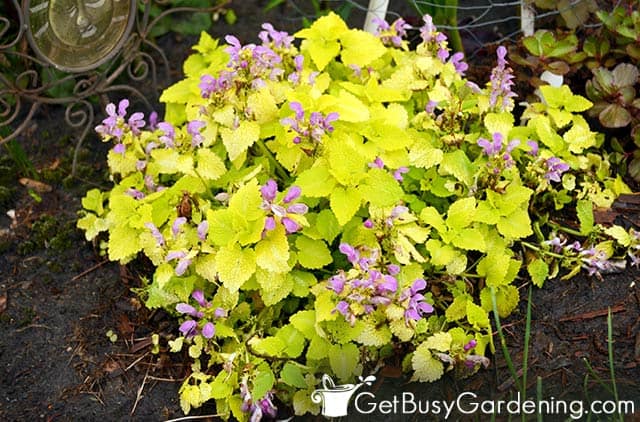
16. Obedient Plant (Physostegia)
Best for partial shade, obedient plants are hardy additions to gardens in zones 3 to 10.
While all varieties are beautiful, the variegated one is especially nice. Sizes range from 24” to 36” tall.
While some have purple flowers, others produce pink or white blooms in late summer. You’ll get a lovely pop of color at the end of the season with these pretty plants.
They can be fairly aggressive spreaders in moist, humus rich soil. So if that’s a concern, plant it in a dryer location.
17. Spurge (Euphorbia)
Thriving in partial shade, spurge has intense green foliage and flowers in several colors, including yellow, red, purplish, dark burgundy, or orange.
These vivid plants are a great addition to any shady garden bed in zones 4-9. While there are tons of different varieties, I really like cushion spurge.
In the spring, the leaves start out green with bright yellow tips. Then it grows into an eye-popping mound covered by neon yellow flowers in early summer.
The stems of mine collapse after the flowers fade. So I just cut it back to the ground during the summer, which opens up the space for other plants to fill in.

With so many colorful options for shade garden plants, there’s no reason to stick with the same old boring ones. Think a little outside the box, and use this list to find gorgeous plants to fill those low light areas.
Recommended Reading
- Grow a Fabulous Garden that Lightens up the Shadows
- Dazzling Plants, Design Ideas, and Proven Techniques for Shade
- Planting the Dry Shade Garden
- Shade-Loving Plants for Year-Round Interest
More Shade Gardening Posts
- 17 Best Ground Covers That Grow Well In The Shade
- 15 Shrubs For Partial Shade In Your Garden
- 40+ Vegetables That Grow In Shade
- 29 Rain Garden Plants For Sun Or Shade
What are your favorite plants for shade gardens to add to this list?

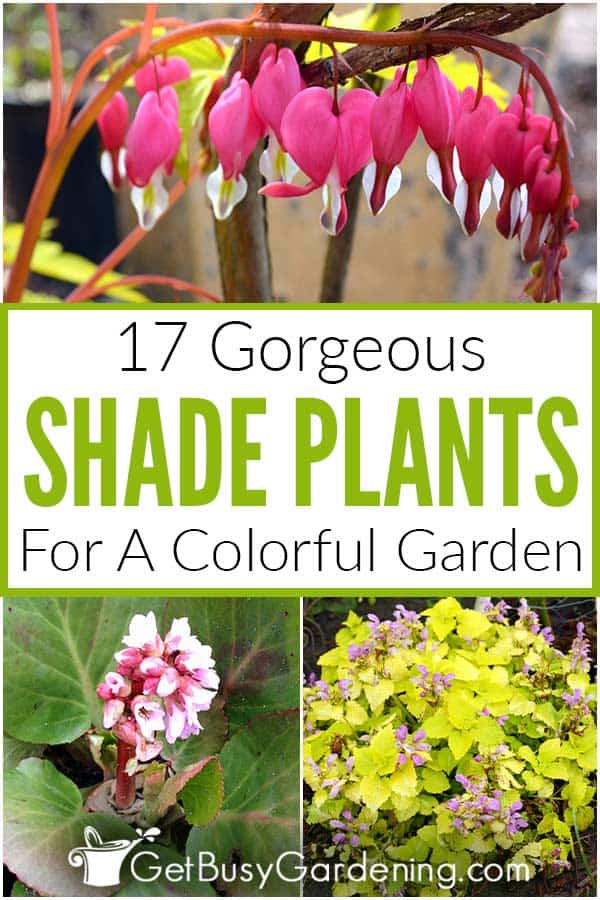
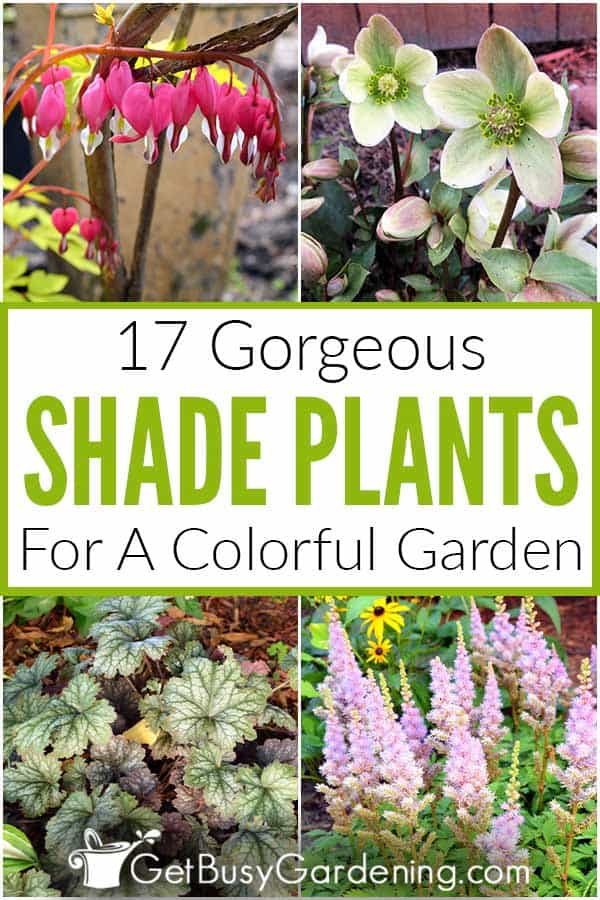


Ann says
The bleeding hearts is my favorite! Not sure if it would fit in my balcony garden. The area gets partial to full sun during the year. I love their color though! Thank you for sharing!
Amy Andrychowicz says
They are one of my favorites too! They can take full sun in early morning or in the evening, but should be shaded from the hot afternoon sun. I’ve never tried growing them in pots before, it’s worth a try.
Chel says
Hi Amy,
Thanks for the creative gardening ideas for colorful shade gardens.I am loving these plants!I think they will be a great addition to my garden.
Amy Andrychowicz says
You’re welcome!
Pamela says
I always love a touch of color in my shade garden! We added some pretty pink and red around the garden of green!
Amy Andrychowicz says
Me too, love it!
Emily says
These are all great suggestions! We don’t have many shady spots in our yard, but I am always looking for plant ideas. Plus, we have too many deer for hosts to survive, so it’s nice to bookmark some other options.
Amy Andrychowicz says
Awesome! You’re welcome. Yes, deer LOVE hostas! Here are some deer resistant plants that should help you find more options.
Laura says
Amy, these are wonderful shade plant suggestions.
Amy Andrychowicz says
Thanks!
Nicole says
This is a great list. We have a super shady spot under a big tree in our yard and I’ve been searching for a while for plants that might work back there!
Amy Andrychowicz says
Awesome!
Vanessa D. says
I like my hostas a lot, but I like many of the ones you’ve mentioned here too. I have a Pink Fizz Heucherella that has been in flower since the end of May and the Hellebore started even earlier. With the right plants, shade gardening isn’t boring at all.
Amy Andrychowicz says
Totally!
Jane Rutkowski says
Nice post. I have a lot shady spots around my yard and this gives me some ideas for NEW plants to try!
Amy Andrychowicz says
Awesome, glad you found the list helpful!
lilly says
Would any of these plants work in zone 8b under an oak tree?
Thanks so much!
Amy Andrychowicz says
I listed the zone ranges for each plant, so take a look at that. All of them would definitely do well under an oak tree. Take the list with you to your local garden center and see what they carry. Have fun shopping!
ramona cagle says
Coral bells,how I love them! I would have them for shade, but I have some which receive quite a lot of sun & they flourish.At last count I have 19 of them & I must add one more to make an even number. Any excuse to add one more.
Amy Andrychowicz says
Yes, they are some of my favorites too! So many colorful options for shade, and they can take some sun too. Have fun shopping for more!
Jen Sabelko says
I was just out in my shade garden today wishing that it wasn’t primarily hosta! Thank you for the great ideas! The helleborus is super cute!!
Amy Andrychowicz says
Awesome! You’re welcome, and happy shopping! 🙂
Alvin says
My favourite one is coral bell and thanks for sharing this info!
Amy Andrychowicz says
Awesome, thanks!
Amy
Penny says
One of my favorite shade plants is Jacob’s Ladder. It never seems to get mentioned. It self-seeds but is not invasive. Pretty blue delicate flowers in spring, variegated fern like foliage thru out the summer.
Amy Andrychowicz says
I love Jacob’s Ladder, thanks for adding that one to the list! 🙂
Catharine says
What would the range be for how many hours of direct sunlight a day an area gets to be right for a shade garden? 1-3? 2-4? I have recently been photographing my yard during the day to see how many hours of sun each area gets since most of it is fairly shady.
Amy Andrychowicz says
Mostly shade refers to an area that receives less than 3 hours of direct sunlight each day, with the bulk of the sun exposure occurring during either early morning, late afternoon or dappled throughout the day. Full shade is an area that doesn’t get any direct sun exposure, but may receive bright, indirect light.
Here’s a post I wrote that has definitions of all the different types of exposures, and how to figure it out… How to Determine Sun Exposure in Your Garden.